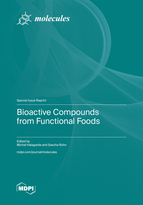Bioactive Compounds from Functional Foods
A special issue of Molecules (ISSN 1420-3049). This special issue belongs to the section "Food Chemistry".
Deadline for manuscript submissions: closed (30 November 2023) | Viewed by 30814
Special Issue Editors
Interests: traditional, regional and organic foods; bioactive compounds in foods; enriched bakery products; food product development; food quality; food authentication
Special Issues, Collections and Topics in MDPI journals
Interests: food proteins; secondary plant metabolites; compound stability and interactions
Special Issues, Collections and Topics in MDPI journals
Special Issue Information
Dear Colleagues,
Functional foods are still gaining widespread consumer interest, mainly due to their beneficial effects on humans. Their action is primarily connected with the content of bioactive compounds. These compounds are mainly plant secondary metabolites (e.g., flavonoids, carotenoids, phenolic acids) applied to recipes as pan extracts or sometimes pure compounds. However, primary plant metabolites and sometimes compounds from animal sources (e.g., selected peptides, vitamins, minerals and fatty acids), as well as compounds from other sources such as single cells (e.g., yeasts, bacteria, algae) can be considered functional ingredients. Biologically active compounds demonstrate various positive physiological and immunological functions. Some act as antioxidant agents and thus can diminish the risk of various diseases, including cancer. Others stimulate defense mechanisms, prevent widespread damage or enhance cell repair. One of the limitations of the application of functional ingredients is their stability, but other main challenges include finding optimal concentrations and recipes.
This Special Issue of Molecules aims to bring together the latest knowledge, ideas, considerations, and overviews on bioactive compounds that can be found in functional foods. We will highly appreciate contributions related to the identification and roles of bioactive functional food constituents, as well as all aspects of the challenges mentioned above. Original research and review articles on the enhancement of foods with functional, biologically active ingredients are also welcome.
Dr. Michał Halagarda
Prof. Dr. Sascha Rohn
Guest Editors
Manuscript Submission Information
Manuscripts should be submitted online at www.mdpi.com by registering and logging in to this website. Once you are registered, click here to go to the submission form. Manuscripts can be submitted until the deadline. All submissions that pass pre-check are peer-reviewed. Accepted papers will be published continuously in the journal (as soon as accepted) and will be listed together on the special issue website. Research articles, review articles as well as short communications are invited. For planned papers, a title and short abstract (about 100 words) can be sent to the Editorial Office for announcement on this website.
Submitted manuscripts should not have been published previously, nor be under consideration for publication elsewhere (except conference proceedings papers). All manuscripts are thoroughly refereed through a single-blind peer-review process. A guide for authors and other relevant information for submission of manuscripts is available on the Instructions for Authors page. Molecules is an international peer-reviewed open access semimonthly journal published by MDPI.
Please visit the Instructions for Authors page before submitting a manuscript. The Article Processing Charge (APC) for publication in this open access journal is 2700 CHF (Swiss Francs). Submitted papers should be well formatted and use good English. Authors may use MDPI's English editing service prior to publication or during author revisions.
Keywords
- functional foods
- biological activities
- secondary metabolites
- phytonutrients
- nutraceuticals
- new foods and formulations
- bioactive potential
- functional characterization
- isolation of bioactives
Related Special Issue
- Bioactive Compounds from Functional Foods, 2nd Edition in Molecules (1 article)








